In Celebration of Queer Anime: Its History, What to Watch, & What’s Next
Photo Courtesy of MAPPA TV Lists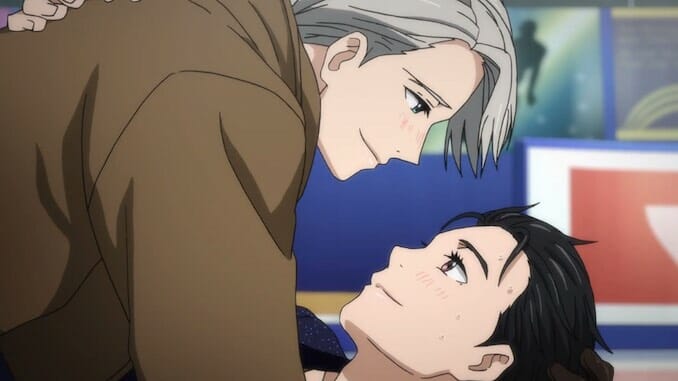
Queerness in Japan has a tumultuous history. At one time, long ago, Japan had fairly open attitudes towards gender and sexuality. Same-sex relationships existed in the culture, and if you consider male Kabuki actors presenting as female in their everyday lives, as the famous Kabuki actor Yoshizawa Ayame did, there was at least a conversation to be had about transgender identity. Japan’s more recent history, however, is of a country that took a sharp turn towards conservative values. During the Meiji Era of the late 19th century, Japan made a concerted effort to emulate Western attitudes of the time. The country would become critical of homosexuality and literature featuring queer themes, seeing queer life as deviant.
The country remains conservative to this day, still not recognizing same-sex relationships and doing little to secure LGBTQ rights. But anime has long been a place where queer expression flows freely. In many cases, anime has been the medium of choice to protest dominant political ideologies, championing queer characters through LGBTQ anime series in a society that refuses to acknowledge their existence.
At a time when queer media is being threatened by out-of-touch senators and pearl-clutching Republicans across the United States, and continues to exist precariously on the fringes of Japanese society, this Pride Month, let’s talk about some exceptional queer stories in anime.
![]()
The Early Years

In the 1960s and 1970s a counterculture was starting to form in Japan. Protests against conservative institutions and the rise of women’s liberation groups created an audience for more openly expressive manga and anime. Many of the works that would begin to challenge heteronormativity and play with gender identity were written by a group of women known as the Year 24 group.
Started as a manga by Keiko Takemiya in the 1970s, but airing as an Original Video Animation in 1987, The Song of Wind and Trees is one of earliest examples of what would now be considered a Boys’ Love anime. The story is set at a fictional all-boys boarding school in the south of France. The star-crossed lovers at the center of the story are Serge Battour and his roommate, the mercurial Gilbert Cocteau. What is immediately apparent is how impossibly beautiful these boys are. Compared to their classmates, Serge and Gilbert stand out. Drawn with feminine features, and in particular, the glittering, saucer-like eyes much more commonly seen on female characters of the time, Serge and Gilbert are prototypical examples of the bishonen, or “beautiful boy,” in anime. Occupying a space between male and female, the bishonen embodies all things beautiful and cares not for any notion of a gender binary. The bishonen operates with a fluidity that defies classification. This goes back well into Japanese history, when young men known as wakashu were considered to be Japan’s “third gender”, and continues in manga and anime today.
Stories like The Song of Wind and Trees feature, at their core, queer romance that is often tragic. Gilbert is a boy who has been abused, and continues to be used as a sexual object. Serge tries to save Gilbert, but faces harassment and bullying from his classmates for doing so. Their relationship is fraught with obstacles. Yet, despite this (and a short 60-minute run time), their love does shine through. The anime doesn’t shy away from depicting male-on-male romance and has a palpable sexual tension running through it. Anime (and manga) like The Song of Wind and Trees were dramatic and liberating. They fought against a conservative culture that valued the nuclear family and heteronormativity above all else. This was also a time when the envelope was pushed by some groundbreaking women.
![]()
The Lost Decades
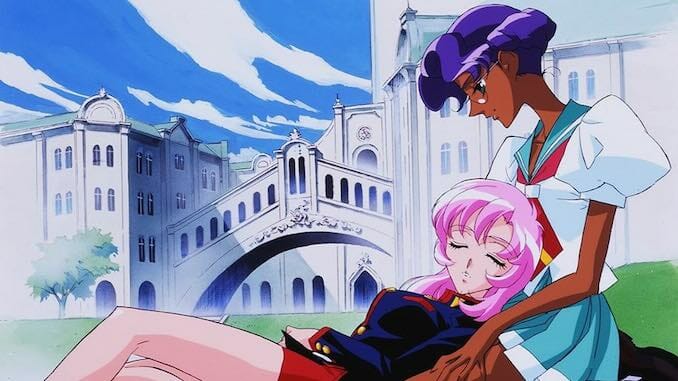
Written by Chiho Saito and directed by the legendary Kunihiko Ikuhara, 1997’s Revolutionary Girl Utena challenges gender norms and oozes with queer energy. A surrealist fairytale steeped in abstract visuals and layers of metaphor, Revolutionary Girl Utena tells the story of the eponymous Tenjou Utena as she searches for a mysterious prince who gave her a rose-engraved ring many years ago, though there is a lot more going on than just that. Explaining the plot of Revolutionary Girl Utena is a fool’s errand. It’s best to just let the show do the talking. What makes Utena an iconic character is her refusal to go along with the gender norms of her school, Ohtori Academy, and the challenge she presents to patriarchal structures: Utena wants to be a prince, despite being told that she can’t be one; she refuses to wear the female school uniform, much to the chagrin of the school’s administration; she is in a lesbian romance with Himemiya Anthy that forms the core relationship of the series; she exhibits unladylike behavior by engaging in duels against combatants who challenge her love of Anthy. At every turn, she refuses the role she is “expected to play” as a woman. She is a revolutionary girl.
Japan in the 1990s was worlds apart from the excess and extravagance of the 1980s. This was largely due to the country’s economic bubble bursting, leading Japan into a deep recession. In the wake of the collapse, the blossoming counterculture and queer narratives that had made inroads, were displaced and returned to marginalized status as a recentering of “family values” took hold. There was no time to explore sexuality, and the nation grasped at traditional patriarchal structures to provide stability in uncertain times. Utena arrived and challenged these norms that were trying to reestablish themselves. The series is one of the most influential anime of all time, and is often cited as an inspiration by artists today. Rebecca Sugar, the creator of Steven Universe, has said that Utena was “an epiphany for her.
Director Kunihiko Ikuhara has always celebrated queer characters in his works, before Utena, he oversaw the arcs in Sailor Moon that feature the iconic couple Sailor Uranus and Sailor Neptune. (Yes, they’re a couple, English dub. Deal with it.) He then directed 2015’s Yurikuma Arashi, another queer series dripping in metaphor and symbolism centered around lesbian bears (yes, you read that right). Most recently, Ikuhara directed 2019’s Sarazanmai, which features a gay boy with a serious crush on his best friend. All are great, and worth checking out.
![]()
What Are Boys Made Up Of? What Are Girls Made Up Of?
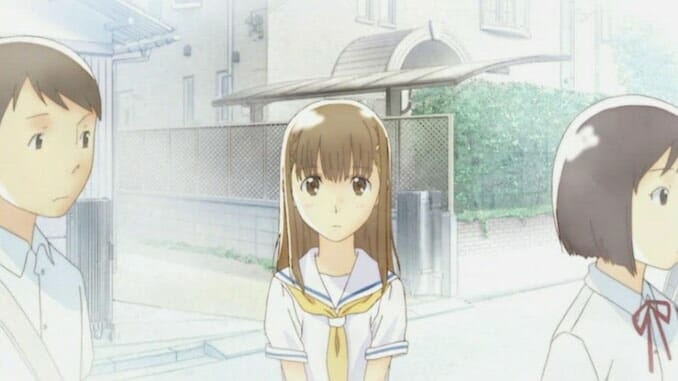
When it comes to queer stories in anime, the majority focus their narratives on gay and lesbian characters. There is less representation for transgender individuals. Having said that, one of the best queer stories in the medium is 2011’s beautiful Wandering Son. The story by Takako Shimura follows middle schooler Shuichi Nitori, who is born male but identifies as female. The entirety of the manga tells Nitori’s story from late elementary school through their college years, but the anime focuses on their time in middle school. This is a particularly crucial time for a young transgender person, and in Nitori’s case, the hormones brought on by puberty begin to affect their ability to conceal the maleness they are trying to transition away from.
Transgender rights in Japan are virtually non-existent, and the process required to have one’s affirmed gender legally recognized is intrusive and littered with roadblocks. When Human Rights Watch is up in arms about your discrimination situation, it’s a problem. First off, a person who wishes to transition must be over 20 years of age, not married, and not have any children under the age of 20. A transgender person in Japan must be diagnosed specifically with “Gender Identity Disorder,” but finding a doctor that will give that diagnosis can be a challenge. Finally, in order to be legally recognized as the gender one is transitioning to, sterilization surgery is required. Stigma and discrimination follow transgender individuals at every turn in Japan. They may even be passed up for promotions at work, as private companies in Japan are somehow within their rights to only promote those who are married and have, or are planning to have, children.
Wandering Son doesn’t pull punches with its depiction of the bullying and discrimination that Nitori faces. They experience a lot in the 11-episode series. But they do have allies who stand by them, and what we see is a young transgender person who knows who they are, who they want to be, and is committed to the difficult road that lies ahead of them. The anime makes a strong case for young transgender individuals being much more aware of their own gender than the adults around them who try to impose laws or think they know better. Nitori knows who they are, and they struggle emotionally because none of the authority figures in their life recognize this. This reverberates all the way to the United States, where legislation outlawing gender-affirming care in 15 states is threatening the wellbeing of transgender youth. Wandering Son is a hugely important queer anime, and while it may not be perfect, for a story like this to even make it as an anime, in a country that does next to nothing to help transgender individuals, it’s a must-watch. Sadly, Wandering Son is not available on any streaming service, so actually finding it is a bit of a challenge—but seek it out by any means necessary (and get on Twitter and tell @Crunchyroll to re-up that license!)
![]()
When Queer Love Gets Real
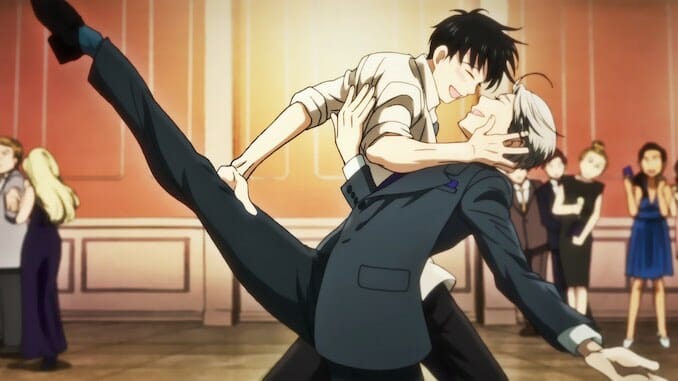
In recent years, there have been a flood of anime that are taking queer love seriously. In the past, a not insignificant amount of the queer anime out there sought to titillate, provoke, and featured queer love that suffered from toxic relationship traits. What is starting to happen is a change in theme towards presenting queer love as a normal part of everyday life; a beautiful lived experience that is no different than the heterosexual love Japan has so thoroughly ingrained into its culture. While there might still be tropes in the writing, it’s the little things that are finding their way into the narratives of queer anime that make these romances feel more authentic, more real.
While this trend has been building, the show that achieved true mainstream success centered around a gay romance is 2016’s Yuri!!! On Ice. Figure skater Yuri Katsuki considers hanging up his skates after a run of poor performances at international competitions, suffering from anxiety on the ice—he’s all in his head. But when his idol, Victor Nikiforov, seeks out Yuri to coach him back to greatness, he decides to give competition a try once more. Along the way, he begins to fall for Victor.
Yuri!!! On Ice felt like lightning-in-a-bottle when it hit the scene. The reason for its success is likely due to a couple of factors. First off, the gay romance at the center of the show is done well, featuring some downright cute moments between the leads, but unafraid to pepper in bold moments that affirm the strength of Yuri and Victor’s relationship. Secondly, Yuri!!! On Ice is a really good sports anime. A tried and tested genre, the sports anime lives and dies on the strength of its narrative, usually one of overcoming obstacles to reach the pinnacle of sport, and its characters. Yuri!!! On Ice does this well, and with great attention to detail regarding the sport of figure skating. You can’t help but cheer for Yuri both on and off the ice. The show ventures further into uncharted territory by addressing same-sex marriage, something that isn’t legally recognized in Japan, though some local governments are now providing rights for same-sex unions. The pressure being applied to Japan’s conservative national politics is slowly ratcheting up, and anime is playing a part in that.
2018’s Bloom Into You features a budding lesbian romance that is filled with tender moments of a first love. There is a lot of tension between Koito Yuu and Nanami Touko as they navigate the minefield of high school while trying to understand their feelings for one another. Holding a hand, stealing a kiss when they think no one is looking, supporting one another no matter what. Is this what love is? Bloom Into You is an interesting one as there is a lot of push and pull between the two leads. Koito and Nanami are at times aggressive, pushing the relationship forward, but are equal parts timid; unsure if the other feels the same way. The show captures this nuance well. But what really sets Bloom Into You over the top is its inclusion of queer adult characters. The girls and their friends frequent a café near their school to kick back, gossip, or discuss school projects. When their teacher, Ms. Hakozaki, happens to walk in and is greeted by the café’s female owner, Miyako, with a familiar “welcome home,” the secret is out. Later on, Sayaka, a girl with a crush on Nanami, reaches out to Miyako for advice on how to handle her feelings, and Miyako is able to help Sayaka with what may lie ahead.
This is a pretty big deal as it stands up against the belief that queer love is something that is only experienced during adolescence, and is eventually abandoned in favor of pursuing straight love. This idea is propagated by conservative groups in Japan that are insistent queer love is nothing more than a phase. It was an idea that bled into literature during the early 1900s where romantic writing might feature a same-sex confession of love, and might even go as far as sexual activity, but that love is “corrected” later on and reduced to a memory: “that one magical summer.” With Bloom Into You (and Wandering Son as well, by the way), these queer adult characters are proof that their love is not “just a phase.” It’s a subtle acknowledgement of queer love as a part of everyday life, found everywhere, and at any age.
![]()
The Evolution of BL
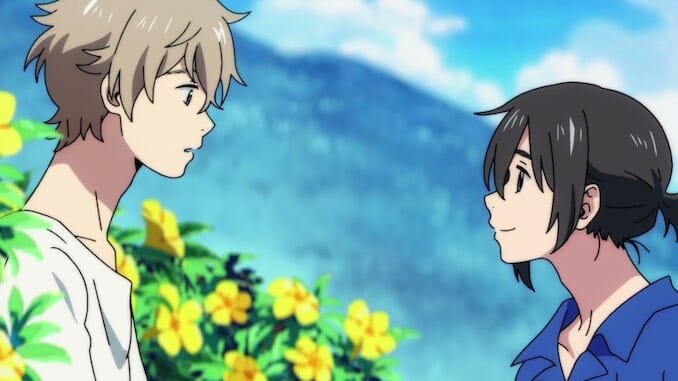
Finally, let’s talk about the most improved anime genre out there, Boys’ Love. BL, for the uninitiated, acts as a catch-all term for pretty much any and all stories that feature male characters in some kind of romantic relationship. Hugely popular in the world of fanfiction, BL dominates almost every convention in Japan for dojinshi (self-published) artists. Media scholar Fujimoto Yukari talks about Boys’ Love through the years, and touches on a valid point of criticism—that for a long time BL was a genre that fetishized gay romance and was out of touch with reality. How quickly things can change.
In the last few years, Boys’ Love anime have been some of the best romance anime out there, hands down. Excellent straight romance anime from days long since past like 2007’s Clannad or 2008’s Toradora are most definitely in the queer-view mirror at this point, as Boys’ Love has taken the wheel. (Yes, I’m aware that straight romance isn’t dead yet. 2016’s A Silent Voice exists and is awesome.)
The 2016 movie Classmates is an opposites attract situation wherein the cool, guitar-playing Hikaru Kusakabe falls for the nerdy, uptight Rihito Sajo. Kusakabe takes the lead, while Sajo is a bit more reticent. There is very little in the way of melodrama, something Boys’ Love has a propensity to lean into. It’s all the little bits of banter and subtle reactions that make the characters feel real, like when Kusakabe invites Sajo to his band’s live show matter-of-factly after leaning in for a kiss, flustering poor Sajo. Moments where jealousy or uncertainty creep in are offset by sweet, intimate resolutions.
The 2019 series given is also centered around music as four bandmates catch feelings bad for one another. With a bit more time to breathe over 11 episodes and a movie-length sequel, given’s relationship arcs are a slow burn. As the narrative fire smolders at a relaxed pace, crackles and pops of drama might seem a tad overwrought, but are generally well earned and fit the mood of a band trying to realize their potential while dealing with hormonal overload. Cathartic moments are felt after a lot of “will they, won’t they” and missed opportunities to confess. given doesn’t break new ground, but it showcases how relationships in BL anime can be written well, and avoid some of the toxic tropes of the scene, by presenting believable, complex relationships.
Last, but certainly not least, 2020’s The Stranger By The Shore, which takes place on a small island in Okinawa, has a beautiful setting that the film’s artists go for broke in depicting. Each scene is filled with gorgeous, densely layered background art. Hashimoto Shun, a young author who struggles with his sexuality, has a chance encounter with Chibana Mio after noticing that Mio often hangs out by the shore across the way from Shun’s grandmother’s café/hostel. There is immediate chemistry between the boys, but Shun can’t open up. He was bullied as a high schooler and more or less disowned by his parents after coming out.
Unlike a lot of Boys’ Love material, Stranger addresses the reality that many queer youth in Japan (and in many places around the world) face, ostracization & othering. This hangs over Shun immensely, and it’s through Mio and his support network in Okinawa that Shun begins to let go of his anxiety. Both characters also admit to having had straight relationships, which could be a claim to bisexuality (something Mio is fairly open about), but could also be a case of keeping up appearances, as queer people in Japan may hide their orientation behind a hetero marriage. Shun seems to fall into the latter category, which is something else he has to address in the film.
Stranger By The Shore is also noteworthy for having its characters go all the way, in a tastefully done scene that feels intimate without being gratuitous. In a lot of cases, censorship gets in the way as production committees and TV networks fret over queer love. Even Yuri!!! On Ice somewhat covers up a kiss, which may have been the result of corporate meddling, if internet rumors are to be believed. For Stranger to be given the go ahead for a sex scene, feels like a win.
![]()
Hope for the Future
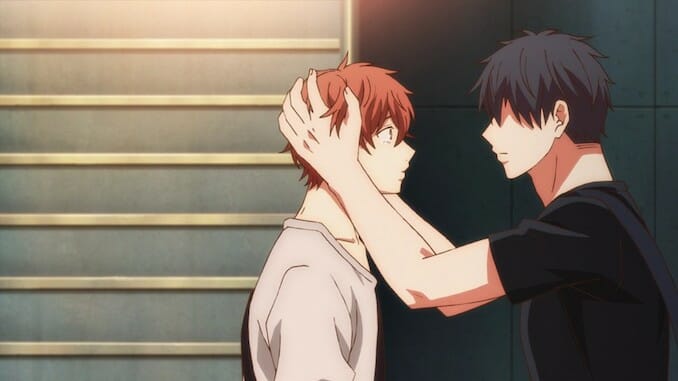
Anime offers a lot of hope for the queer community; its track record shows that it has long been the medium leading the charge for LGBTQ representation, and continues to highlight the issues that still remain as barriers to equality. From Serge and Gilbert’s beautiful, shocking, tragic love that broke ground in the 80s, to the supportive, intimate love Shun and Mio show us today, queer anime needs to be supported to continue raising awareness and changing minds.
It seems to be working in Japan, as more local governments are recognizing same-sex couples, with support for equality swelling. A recent ruling on Japan’s same-sex marriage ban found the ban to be unconstitutional, so the tide does feel like it’s turning. Queer anime continues to play a part in the push for LGBTQ rights in Japan, and with anime’s greater visibility and influence across the globe, watching, supporting, and promoting queer anime is important here, too. It also helps that a lot of it is really good.
“This is an ordinary love story, that took place one ordinary spring.” says Nakayama Haruki in given.
It’s just that simple. How can anyone hate on that?
Michael Lee is a writer who might take anime and video games a little too seriously. For more musings on animation, fandom, and game worlds, follow him on Twitter @kousatender.
For all the latest TV news, reviews, lists and features, follow @Paste_TV.